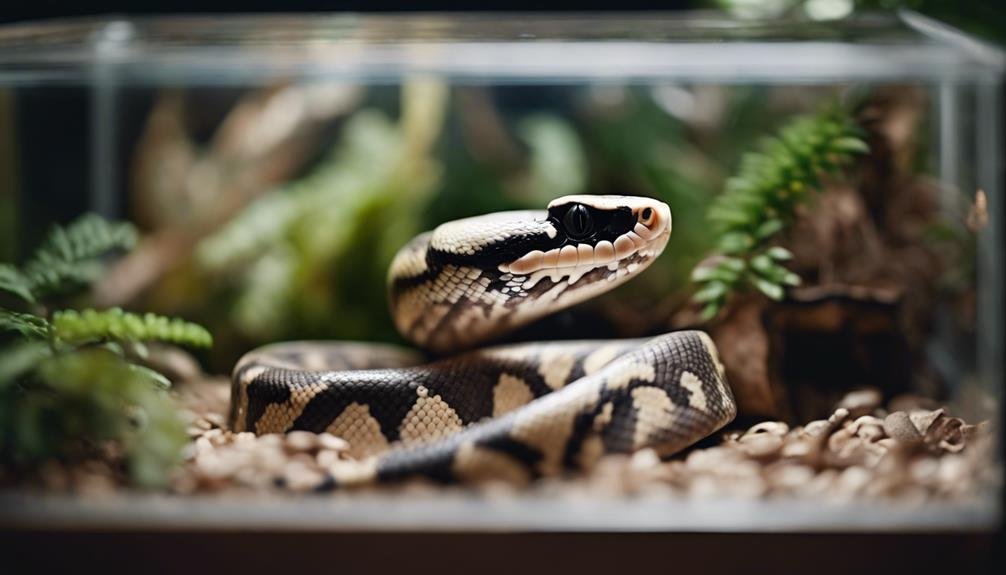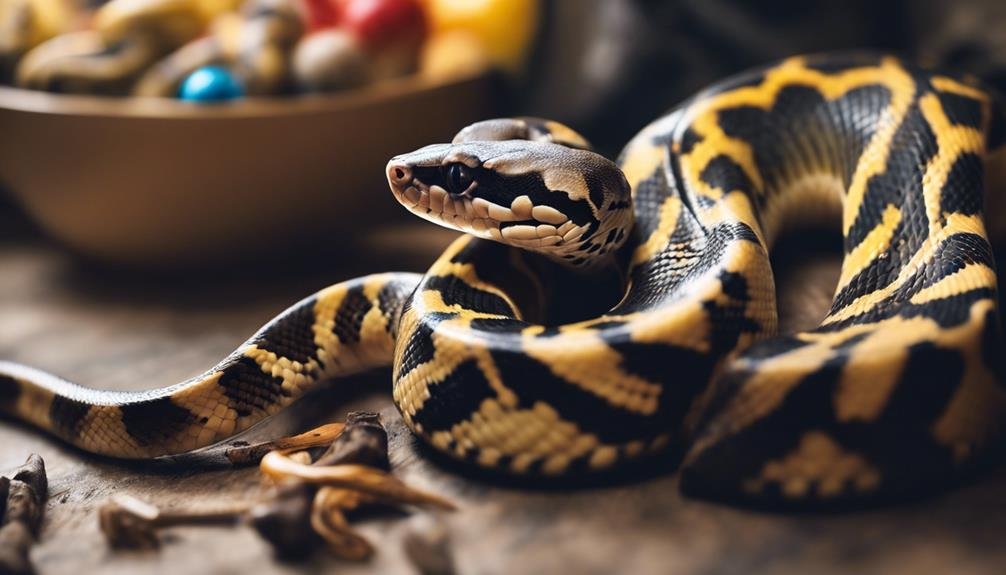Have you noticed your ball python struggling to shed its skin? Often, the key factor lies in the environment you’ve created for them. If the humidity and temperature levels aren’t just right—typically between 50-60% humidity—your snake might face challenges, such as retained eye caps or incomplete shedding. Adjusting these conditions is important, but there’s more to understand about fostering an ideal shedding process. From the benefits of a humid hide to the nuanced balance of their nutritional needs, uncovering the layers of proper shedding care can greatly impact your pet’s health. Let’s explore how you can transform their enclosure into a shedding-friendly habitat, ensuring your ball python’s skin health and overall well-being are in top condition.
Key Takeaways
- Inadequate humidity levels in the enclosure can prevent successful shedding in ball pythons.
- Low temperatures or improper temperature gradients can hinder the shedding process.
- Stress caused by factors like inadequate hiding spots or excessive handling can interfere with shedding.
- A lack of proper hydration can lead to dry, flaky skin, complicating the shedding cycle.
- Nutritional deficiencies, especially in vitamins and minerals, can result in shedding issues.
Identifying Shedding Problems
To spot shedding issues in your ball python, look for signs such as retained eye caps, dry, flaky skin, or patchy shedding. These symptoms are clear indicators that your pet is experiencing discomfort during its shedding process. Retained eye caps, also known as spectacles, can particularly signal that there’s a problem. This condition affects your snake’s appearance and can lead to more serious health issues if not addressed promptly.
When you notice your ball python’s skin looking dull and flaky, it’s a heads-up that the shedding cycle mightn’t go as smoothly as it should. Incomplete or patchy shedding is another red flag. If the old skin doesn’t come off entirely, this situation can cause your snake discomfort and, worse, lead to skin infections.
These shedding problems often involve the environment within the enclosure, with inadequate humidity levels being a primary culprit. While it’s tempting to dive straight into solutions, understanding that these issues stem from environmental factors is important. You’ve got to keep a close eye on your python’s shedding frequency and quality. Catching these signs early makes all the difference in managing your pet’s health and comfort.
Importance of Humidity
Understanding the importance of humidity for your ball python’s health is key to avoiding shedding issues. If the humidity in their enclosure isn’t correct, you’ll notice problems like retained shed or dry, tough skin.
We’ll explore how to maintain ideal humidity levels, recognize signs of low humidity, and adjust techniques to guarantee your snake sheds successfully.
Optimal Humidity Levels
Maintaining ideal humidity levels, around 50-60%, is crucial for your ball python’s health and successful shedding. Inadequate humidity can lead to significant shedding issues, making it tough for your pet to remove its old skin. This can result in retained shed, which is uncomfortable and potentially harmful.
To guarantee appropriate conditions, consider the following:
- Monitor humidity levels with a digital hygrometer to keep track accurately.
- Consistent humidity is key to preventing skin complications and ensuring smooth sheds.
- Recognize the role of humidity in softening the old skin, facilitating an easier and healthier shedding process.
Signs of Low Humidity
Recognizing signs of low humidity in your ball python’s environment is essential for preventing health issues and ensuring a smooth shedding process. If you notice your snake experiencing difficulty shedding, with retained eye caps and dull skin, it’s likely suffering from low humidity levels.
Proper humidity is vital, ranging from 50% to 60% on the cool side and 60% to 70% on the warm side of their enclosure. When humidity drops below these levels, your ball python can face serious challenges, including dehydration and an increased susceptibility to infections.
Additionally, inadequate humidity can lead to respiratory problems, making it harder for your snake to breathe comfortably. Ensuring the right humidity levels is key to preventing retained shed and safeguarding your pet’s health.
Humidity Adjustment Methods
To guarantee your ball python sheds successfully, it’s important to carefully adjust humidity levels in its enclosure. Maintaining proper humidity between 50-60% is vital for effective shedding. Inadequate moisture can lead to retained shed, causing discomfort and potential health issues.
Here are three key methods to adjust humidity:
- Use a digital hygrometer to monitor and adjust humidity levels within the enclosure accurately.
- Provide a humid hide or moist substrate to create a microclimate that supports shedding.
- Make consistent humidity adjustments based on shedding cycles to promote successful shedding.
Creating the Ideal Environment
Creating the perfect environment for your ball python’s shedding process requires careful attention to humidity and temperature levels. To kick things off, maintain a humidity level between 50-60%. This range is vital for a successful shed.
A handy trick is providing a humidity box filled with damp moss, which can greatly aid the shedding process.
Equally important is ensuring a proper temperature gradient within the enclosure. You must maintain a cool side at 78-80°F and a warm side at 88-92°F. This gradient allows your ball python to regulate its body temperature by moving between the cooler and warmer areas, facilitating the shedding process.
Regular misting of the enclosure can be incredibly effective in keeping humidity levels within the ideal range. However, it’s not just about guesswork. To monitor these environmental conditions accurately, a digital hygrometer and thermometer are recommended.
Humid Hide Benefits
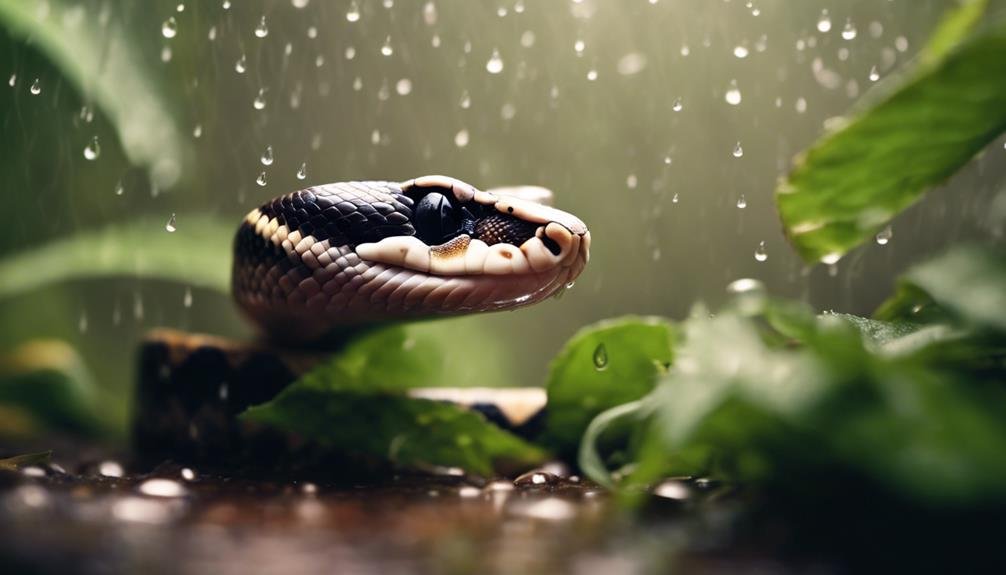

Understanding the benefits of a humid hide is essential for your ball python’s shedding process.
You’ll find that maintaining ideal humidity levels and considering the design of the hide can greatly assist in shedding.
Let’s explore how proper hide setup and shedding assistance techniques can prevent common issues and promote a healthier snake.
Optimal Humidity Levels
Maintaining humidity levels between 50-60% in their enclosure for ball pythons is essential for facilitating smooth shedding processes. Ensuring these ideal humidity levels can greatly improve your snake’s shedding cycle, preventing the common issue of retained shed, which can lead to skin problems.
Incorporating humid hides in your ball python’s enclosure plays a vital role in achieving this:
- Humid hides provide a microclimate with higher humidity, which is important for the shedding period.
- Softening the old skin becomes more manageable, ensuring the entire shed comes off in one piece.
- Maintaining a humid hide with a damp substrate aids significantly in the shedding process, making it stress-free for your ball python.
Hide Design Considerations
After exploring the significance of ideal humidity levels, let’s examine how the design of humid hides can enhance your ball python’s shedding experience.
A humid hide offers a snug microenvironment, essential for softening old skin and ensuring a complete shed. This specialized setup prevents the common issue of retained shed, fostering healthy shedding cycles. The humid hide plays a pivotal role in preserving your snake’s skin health by maintaining increased humidity levels.
It’s not just about providing a hideaway; it’s about creating a space where your ball python can comfortably shed its old skin. Properly designed humid hides are indispensable for avoiding skin-related problems, making them a must-have in your pet’s habitat for optimal skin health.
Shedding Assistance Techniques
Implementing a humid hide in your ball python’s enclosure can greatly enhance its shedding process, offering an important solution to common shedding issues. This method mimics their natural habitat and provides a microclimate that greatly aids the shedding process.
- Increases Humidity Levels: A humid hide boosts the enclosure’s humidity, softening the old skin and making it easier for your snake to shed completely.
- Mimics Natural Environment: By providing a humid hide, you’re closely replicating the natural conditions your ball python would experience in the wild, promoting successful shedding.
- Reduces Health Risks: Using a humid hide can decrease the chances of retained shed and subsequent health issues, ensuring your ball python remains healthy and happy.
Soaking: Pros and Cons
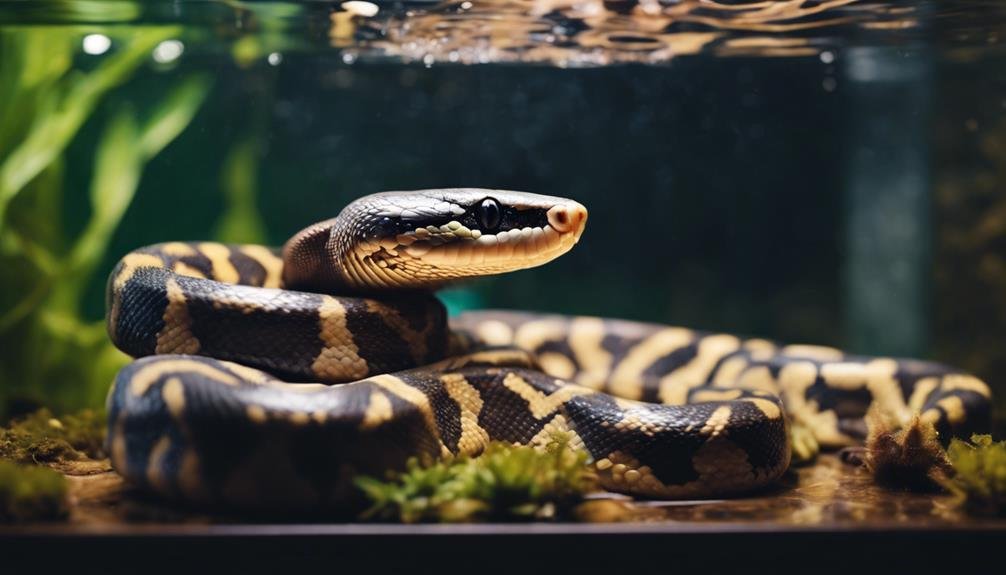

Soaking your ball python has benefits, such as easing the removal of stuck sheds and promoting hydration. Still, balancing these advantages with potential risks like respiratory issues is important. When you notice your snake struggling to shed its skin completely, a soak in lukewarm water can greatly help. This practice softens the old skin, making it easier for your snake to shed it off, thereby maintaining proper skin health. It’s also a method to ensure your snake stays hydrated, vital for its overall well-being.
However, it’s not as straightforward as just putting your snake in water. The temperature of the water should be just right—lukewarm—to prevent stressing your snake, which could have adverse effects. Moreover, there’s a fine line between helping and harming when soaking duration. Over-soaking can lead to respiratory issues, a risk that shouldn’t be taken lightly. Always watch the time and never leave your ball python unattended during soaking.
Before you decide soaking is the right approach to address shedding issues, consulting with a reptile veterinarian can give you tailored advice. This ensures that you’re addressing the immediate problem and doing so safely for your snake.
Temperature Regulation
Ensuring your ball python’s habitat has a precise temperature gradient is vital for its shedding process and overall health. Ball pythons thrive in an environment miming their natural habitat, with a warm side ranging between 85-90°F and a cool side at 75-80°F. This temperature gradient allows them to regulate their body temperature effectively, essential for their shedding cycle. Without the proper temperature settings, your snake might struggle with retained shed, leading to potential skin issues that could impact its well-being.
To maintain a suitable thermal environment for your ball python, consider these steps:
- Monitor Temperatures Regularly: Use reliable digital thermometers to check both ends of the enclosure. This ensures the temperature gradient remains consistent.
- Avoid Temperature Fluctuations: Minimize any sudden temperature changes that can disrupt the shedding cycle. This includes properly positioning heat sources and avoiding drafts.
- Choose Correct Heating Elements: Ensure you’re using and placing the right heating elements correctly to avoid overheating or underheating habitat areas.
Nutritional Factors
Turning your attention to nutritional factors, you must be aware that an inadequate diet can severely impact your ball python’s shedding process. Ensuring your snake gets enough vitamins and hydrates properly is essential for smooth shedding.
If you overlook these aspects, your pet might struggle with shedding due to essential nutrient deficiencies or dehydration.
Inadequate Diet Impact
An inadequate diet lacking essential nutrients can greatly impair the shedding process of ball pythons. When your snake doesn’t receive the right balance of nutrients, its health and ability to shed properly can be greatly compromised. Here’s how diet influences shedding:
- Hydration: Not having enough water leads to dehydration, making skin less flexible and more difficult to shed.
- Protein: Insufficient protein affects skin health and regeneration, which is important for a complete shed.
- Minerals: A lack of essential minerals, especially calcium, can result in poor skin health, further impacting the shedding cycle.
Consulting with a reptile veterinarian can help you address and correct these dietary issues, ensuring your ball python can shed effectively and maintain good health.
Essential Vitamin Deficiencies
Like humans, ball pythons can suffer from essential vitamin deficiencies that complicate their shedding. One critical nutrient they often miss out on is vitamin A. A lack of this crucial component can lead to dry, flaky skin, making it tough for your snake to shed properly. It’s not just about the appearance; inadequate vitamin intake directly impacts the health of their skin and the ease of their shedding cycles.
Vitamin deficiencies can undermine the skin’s elasticity, turning what should be a natural process into a struggle. To prevent these shedding issues, make sure you’re providing a diet rich in essential nutrients, including vitamin A. Proper supplementation can make all the difference, keeping your ball python’s skin healthy and shedding on schedule.
Proper Hydration Importance
Beyond guaranteeing your ball python gets enough vitamins, keeping them well-hydrated is equally important to support a healthy shedding process. Proper hydration isn’t just a matter of necessity; it’s vital for facilitating a smooth shedding cycle. When your snake is dehydrated, it can lead to retained shed and skin issues, which aren’t only uncomfortable for your pet but lead to more severe health problems.
Here are three key steps to ensure proper hydration:
- Provide a large water bowl that allows your ball python to immerse itself if it chooses to fully.
- Ensure regular access to fresh water to encourage drinking and maintain hydration.
- Monitor your snake’s water intake and skin condition, as these can indicate its overall hydration levels and health.
Stress and Its Effects
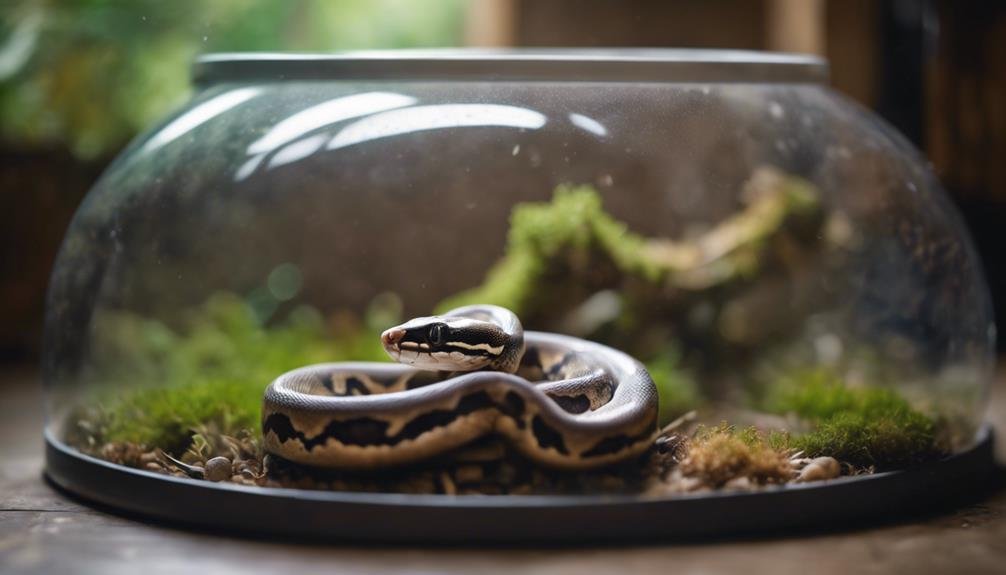

Stress can greatly hinder a ball python’s shedding process, leading to several health concerns if not addressed. When stressed, your snake might retain its shed, triggering a cascade of potential health issues. Factors contributing to stress include inadequate hiding spots and excessive handling, disrupting the natural shedding cycle. It’s vital to watch these environmental stressors to ensure your ball python can shed successfully.
High stress levels interfere with shedding and affect your snake’s overall well-being. The connection between stress and shedding is significant; a stressed ball python will likely face difficulties completing its shed, which can lead to discomfort and, over time, more severe health problems. Monitoring and minimizing stressors in your snake’s environment creates a more conducive setting for shedding.
Addressing stress-related issues promptly is important. This proactive approach can help prevent long-term health complications in ball pythons. Remember, a calm, stress-free environment is key to a smooth shedding process. By ensuring your ball python feels safe and unstressed, you’re laying the groundwork for healthy shedding cycles.
When to Seek Veterinary Care
Recognizing when your ball python’s shedding issues require professional care is vital to their health and well-being. If you notice your snake struggling with prolonged shedding, acting promptly is important. Seeking veterinary care provides relief and prevents further complications and discomfort.
Here’s when it’s time to consult a veterinarian:
- Prolonged Shedding Issues: If your ball python’s shedding process seems endless or notably delayed, it’s a sign that professional help is needed. Delaying could worsen the problem.
- Assessing the Underlying Cause: A veterinarian can determine the root of the shedding difficulty. Whether it’s an environmental factor or something more serious, identifying the issue is the first step toward resolution.
- Addressing Environmental Concerns: Professional guidance can pinpoint snake environmental issues affecting the shedding process. Understanding and correcting these factors ensures your ball python’s habitat promotes healthy shedding.
Seeking veterinary care ensures your ball python receives the proper treatment and care for shedding concerns, addressing the symptoms and the underlying cause. Timely intervention is key to maintaining your snake’s well-being and avoiding unnecessary stress or health issues.
Does Lack of Access to Water Cause Ball Pythons to Have Trouble Shedding?
Some experts believe that ball python water preferences play a role in their shedding process. Lack of access to water can lead to dehydration, which may cause difficulties during the shedding process. Ensuring that ball pythons have proper access to water is essential for their overall health and wellness.
Preventing Future Issues
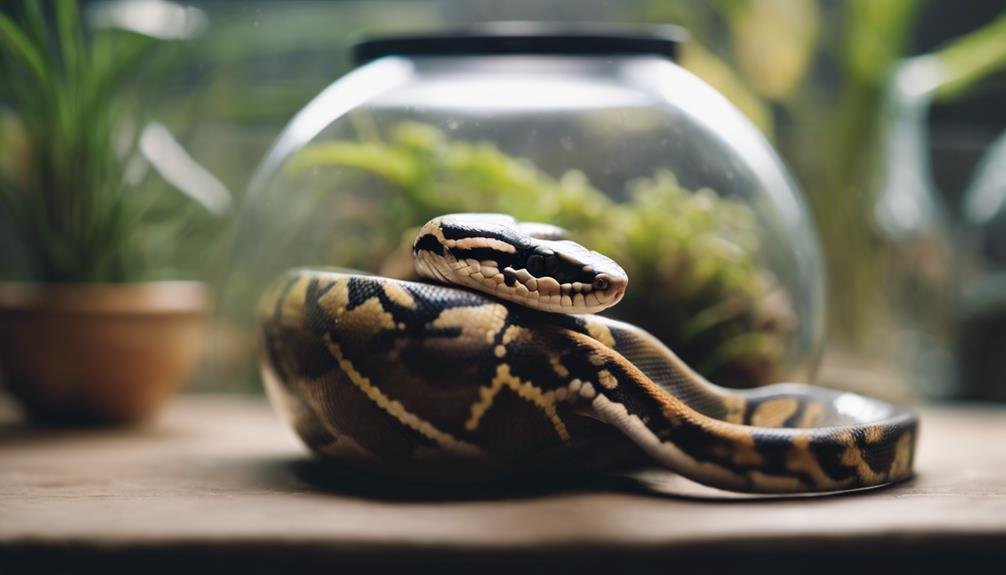

To prevent future shedding issues in your ball python, it’s crucial to maintain proper humidity levels and provide a supportive environment. Achieving the right balance isn’t just about adjusting your room’s humidity; it’s about creating conditions where your snake feels secure and is physically supported through the shedding process. A shedding box filled with damp sphagnum moss can be a game-changer. It offers your python a micro-environment that’s perfectly humidified for shedding.
Regularly checking on your ball python’s skin condition and shedding frequency will alert you to any problems early on, allowing for quick adjustments. Stress can greatly impact your python’s health, so ensuring their home is a sanctuary, complete with hiding spots, is crucial for their well-being. Sticking to a consistent feeding schedule and keeping their enclosure clean can also ward off many shedding issues before they begin.
Here’s a quick guide to keeping shedding woes at bay:
| Factor | Why It’s Important | What You Can Do |
|---|---|---|
| Humidity Levels | Prevents incomplete sheds | Maintain 50-60% humidity |
| Shedding Box | Aids in easy shedding | Provide a box with damp sphagnum moss |
| Stress-Free Environment | Promotes healthy shedding cycles | Ensure enough hiding spots |
| Cleanliness & Diet | Supports overall health, affecting skin health | Keep enclosure clean, adhere to diet plan |
Conclusion
To sum up, if your ball python’s shedding isn’t going smoothly, it’s likely due to environmental issues, with humidity playing a key role. You’ll greatly improve their shedding process by ensuring proper humidity levels, creating a comfy environment with a humid hide, and considering the pros and cons of soaking.
Don’t overlook the impact of nutrition and stress, and when necessary, seek veterinary care to tackle any severe shedding problems. By taking these steps, you’re setting the stage for healthier, hassle-free shedding cycles.

